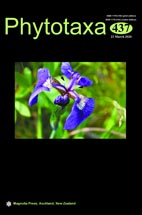Abstract
Back to history, the systematic position of these 3-lobed gynostemium species in Aristolochia has been controversial. They have successively been recognized to be different genera by different authors, i.e., Isotrema Rafinesque (1819a: 195) (Rafinesque 1819b, Huber 1960, 1985, 1993, Wu et al. 2003, 2006, 2011, Eberhard et al. 2015, Liu et al. 2015), Hocquartia Dumortier (1822: 30) or Siphisia Rafinesque (1828: 62) (Rafinesque 1836, Klotzsch 1859). On the other side, the species having 3-lobed gynostemium were also ascribed to Aristolochia subgen. Siphisia (Duchartre 1854: 29) Schmidt (1935: 236) by many researchers (Duchartre 1854, 1864, Bentham & Hooker 1880, Solereder 1889, Schmidt 1935, Hwang 1988, Ma 1989, González 1999, González & Stevenson 2000, Murata et al. 2001, Adams et al. 2005, Xu et al. 2011, Do et al. 2015a, 2015b, Wu et al. 2015, Zhu et al. 2018). Recently, Aristolochia subgen. Siphisia was re-instated as an independent genus Isotrema, which is characterized by the following set of characters: such as a strongly curved perianth with a 3-lobed limb, and especially the 3-lobed gynostemium, anthers paired on the outer surface of each gynostemium segment (Zhu et al. 2019a). It has been adopted when some new species are described (Li et al. 2019, Zhou et al. 2019, Zhu et al. 2019b, Cai et al. 2020a). Most species described under Aristolochia subgen. Siphisia have been transferred to Isotrema (Zhu et al. 2019a), but four new species published after that (Peng et al. 2019, Zhu et al. 2019c, Cai et al. 2020b) have not been transferred to Isotrema and new combinations are still necessary.

